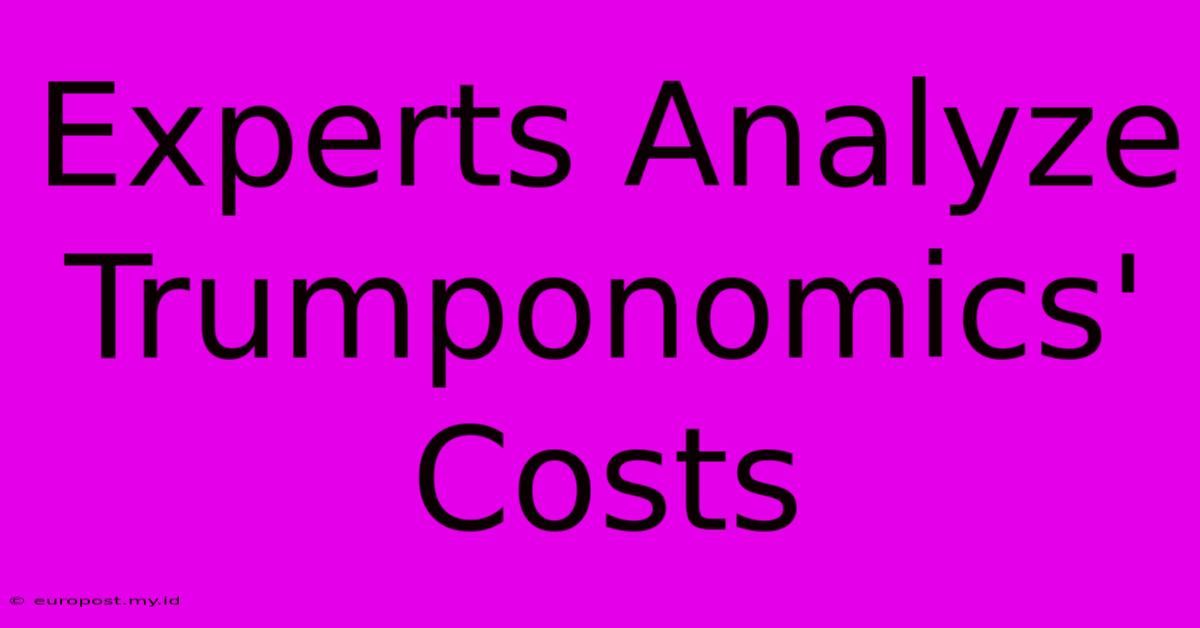Experts Analyze Trumponomics' Costs

Discover more in-depth information on our site. Click the link below to dive deeper: Visit the Best Website meltwatermedia.ca. Make sure you don’t miss it!
Table of Contents
Experts Analyze Trumponomics' Costs: A Deep Dive into Economic Impacts
Introduction:
The term "Trumponomics," coined to describe the economic policies of the Trump administration (2017-2021), continues to spark debate among economists. While proponents highlight certain successes, critics point to significant costs and long-term consequences. This article delves into expert analyses of Trumponomics, examining both its perceived benefits and its considerable drawbacks. We'll explore the key policy pillars, assessing their impact on various economic indicators and considering the lasting effects on the US and global economy.
Key Pillars of Trumponomics and Their Impacts
Trumponomics rested on several core tenets: tax cuts, deregulation, and protectionist trade policies. Let's dissect each element and examine the expert consensus on their costs.
1. Tax Cuts and Jobs Act of 2017: A Mixed Bag?
The centerpiece of Trumponomics was the Tax Cuts and Jobs Act (TCJA). This legislation significantly lowered corporate and individual income tax rates. While proponents argued it would stimulate economic growth through increased investment and job creation, critics raised concerns about its impact on the national debt.
- Arguments for: Supporters pointed to a short-term boost in economic activity and corporate investment following the tax cuts.
- Arguments against: Many economists, however, highlighted the long-term fiscal implications. The TCJA resulted in a substantial increase in the national debt, raising concerns about future economic stability and potential crowding out of private investment. Furthermore, the benefits were disproportionately concentrated among high-income earners, exacerbating income inequality. Studies by organizations like the Tax Policy Center have meticulously analyzed these distributional effects.
2. Deregulation: Risks and Rewards?
The Trump administration pursued a significant deregulation agenda across various sectors, including environmental protection and financial regulation.
- Arguments for: Proponents argued that deregulation reduced burdens on businesses, fostering job creation and economic growth.
- Arguments against: Critics, however, voiced concerns about the potential negative consequences for public health, environmental protection, and financial stability. The rollback of environmental regulations, for instance, drew sharp criticism from environmental groups and some economists who highlighted the long-term costs of environmental damage. Similarly, loosening financial regulations raised concerns about increased systemic risk.
3. Protectionist Trade Policies: A Costly Approach?
Trumponomics embraced protectionist trade policies, including imposing tariffs on imported goods. The rationale was to protect American industries and jobs from foreign competition.
- Arguments for: Supporters argued that tariffs could help revive domestic industries and create jobs.
- Arguments against: However, many economists argued that these tariffs led to higher prices for consumers, retaliatory tariffs from other countries, and disruptions to global supply chains. The resulting trade wars hurt American businesses and farmers, leading to significant economic losses. The impact on specific industries, like agriculture, was particularly severe.
Long-Term Costs and Unintended Consequences
Beyond the immediate impacts, experts are increasingly analyzing the long-term costs of Trumponomics. These include:
- Increased National Debt: The combination of tax cuts and increased spending resulted in a significant expansion of the national debt, potentially limiting future government spending on crucial programs.
- Exacerbated Income Inequality: The tax cuts disproportionately benefited high-income earners, further widening the gap between the rich and the poor.
- Environmental Damage: The deregulation of environmental protections has raised concerns about long-term environmental costs and the potential for increased health problems.
- Weakened International Relations: The protectionist trade policies strained relationships with key trading partners, potentially harming long-term economic cooperation.
Conclusion: A Critical Assessment
The economic legacy of Trumponomics remains a subject of intense scrutiny. While some short-term gains were observed, the long-term costs – particularly the increased national debt and exacerbated income inequality – are significant. Experts continue to debate the precise magnitude of these costs and their long-term ramifications. A comprehensive understanding requires a nuanced consideration of multiple perspectives and a careful analysis of both the intended and unintended consequences of these policies. Further research is needed to fully assess the long-term impact on economic growth, social equity, and international relations.

Thank you for taking the time to explore our website Experts Analyze Trumponomics' Costs. We hope you find the information useful. Feel free to contact us for any questions, and don’t forget to bookmark us for future visits!
We truly appreciate your visit to explore more about Experts Analyze Trumponomics' Costs. Let us know if you need further assistance. Be sure to bookmark this site and visit us again soon!
Featured Posts
-
Fast Boosting Chinas Soft Power
Nov 16, 2024
-
Muhammad Alis View Of Mike Tyson
Nov 16, 2024
-
Tilak Varma Sanju Samson Smash Hundreds
Nov 16, 2024
-
Daring Races A Movie Stars Life
Nov 16, 2024
-
Ronaldos Influence Fernandes Observation
Nov 16, 2024
